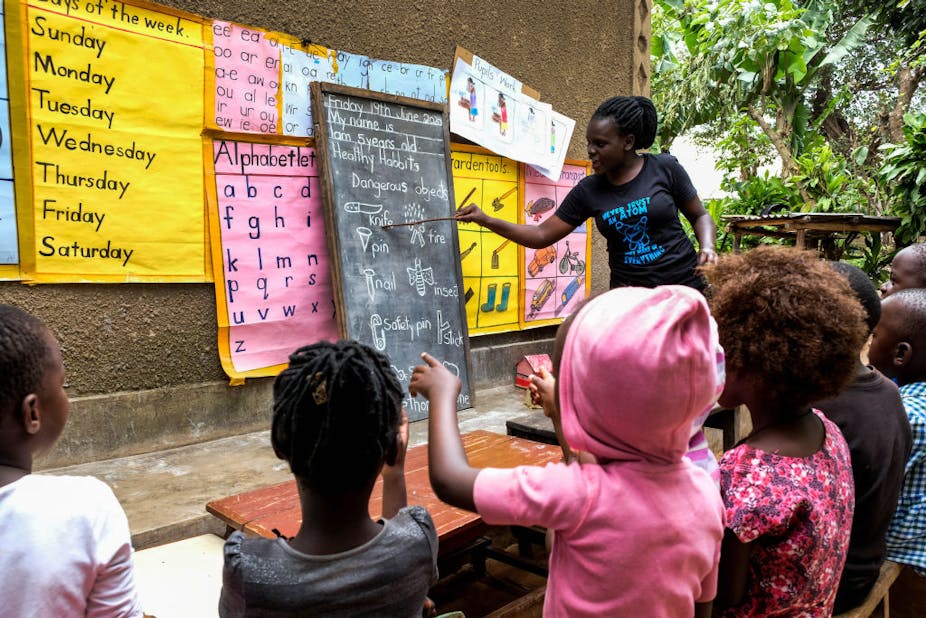Uganda enforced the longest period of school closures worldwide – 22 months – during the COVID-19 pandemic. The strategy was subject to scrutiny by many local and international organisations in view of the multiple challenges the country’s education sector already faced before the pandemic.
Studies of the predicted and already visible impact of COVID-19 on education in sub-Saharan Africa are beginning to reveal how inequities that affected children and their families prior to the pandemic have intensified during and after school closures. It is estimated that 15 million pupils have not attended school in Uganda for almost two years.
Statistical models predict a learning deficit of 2.8 years in Uganda. Other effects include a 22.5% increase of pregnancies among Ugandan school-going girls and young women aged 10-24 between March 2020 and June 2021. There was also an increase of child labour from 21% to 36%, affecting girls in particular.
Some schools have closed for good, as they were either destroyed for new real estate projects or sold.
To understand how the prolonged closure of schools affected the lives of adolescents in Uganda we conducted interviews with 36 young people (18 male, 18 female) living in central Uganda (Luwero and Kampala) and predominantly from a low socio-economic status. Interviews were part of a longitudinal qualitative study, the Contexts of Violence in Adolescence Cohort Study (CoVAC).
While the longer term impacts of COVID-19 on education in Uganda remain to be seen and still need to be studied, emerging evidence from our small cohort study, including other research, shows that the effects for young people have already been devastating. The compound effects of school closures, loss of livelihoods and caregiver stress (especially during lockdowns) also increased the risk of domestic violence, with instances of verbal and physical abuse of children.
Context and intersecting disadvantages
Our study participants were between 15 and 17 years old when we first met them in 2018 and over the next four years we conducted at least six interviews with each young person. We also interviewed their caregivers, teachers or peers so we already knew quite a lot about their lives and challenges.
During the lockdown, we conducted phone interviews between May and June 2020 with 18 girls and 16 boys (mainly aged 16-19 years) who had been participants in our longitudinal study. We interviewed all participants again in 2021.
For the 22 young people (out of the 36) who were in school before the lockdowns, the pandemic seriously disrupted their education. Their experiences varied depending on their socio-economic background, location and gender. We applied an intersectional lens to analyse how pre-existing and intersecting inequities had intensified, with detrimental effects on young people’s educational paths and life circumstances.
For example, young people needed to find ways to generate an income while schools were closed. This posed different challenges depending on gender or location.
Some boys in rural areas migrated to another region to find work, which was often precarious and exploitative. For girls, who tended to be more confined to their homes, and for girls in rural areas, options to earn money were extremely limited. This inability to complete their education, or to work, or to earn enough, was a heavy burden for young people. Some of them felt they had failed.
The pandemic has strained participants’ mental health in multiple ways. They were concerned about whether they would be able to afford to return to school. They expressed feelings of fear, loneliness, anxiety, distress and loss of self-esteem. Very few were able to use distance learning materials.
Several participants experienced unintended pregnancies, reducing their prospects for returning to school. School closures could add to the complex mix of reasons for getting pregnant. Financial pressures, stressful family situations and more free time could all have a bearing.
Structural barriers
Our data also shows that gender, socio-economic circumstances and location have a bearing on the effectiveness of interventions. Not everyone can equally use opportunities to get an education.
Take the example of Atala (not her real name). She is the oldest of five children and helps her mother with chores, childcare and informal sector work. She wanted to train as a nurse but her school results weren’t good enough because – as a girl – she had so many responsibilities. During the first lockdown she was offered a place in a government sponsored vocational training programme in tailoring. But hardly any teaching took place. When the programme finally resumed, classes were rushed. Atala said she got her certificate but didn’t feel qualified to work as a tailor. And she lives in a rural community with no financial means, tools or opportunities to start her own business.
Our study participants’ experiences are a reminder that Uganda’s current challenges in education due to the prolonged closure of schools are not new. Rather, the pandemic worsened existing inequities and structural barriers in education such as: not having access to truly free education; high drop out rates, low learning outcomes or lack of opportunities to find employment after completing school.
These impacts have far reaching consequences for education, reproductive health, mental health, working conditions, and earning opportunities.
Now that schools are open again, we will investigate existing and persisting grievances that affect and disadvantage adolescents, and how they cope with challenges such as paying school fees or catching up with teaching content. Strategies and interventions to ‘build back equal’ can learn a lot from an intersectional lens on the basis of young people’s accounts, their specific challenges, unique circumstances and everyday realities.
Rehema Nagawa, Research Assistant at Medical Research Council/Uganda Virus Research Institute and London School of Hygiene and Tropical Medicine and Dipak Naker, Co-director at Raising Voices and Cofounder of the Coalition For Good Schools, also contributed to this article and the research it’s based on. Karen Devries, Jenny Parkes and Dipak Naker are co- Principal Investigators on the CoVAC study.

